Consumer Electronics Warranties:
While most of the brands are imports, there is a short list of American CE manufacturers. But while the Japanese brands have relatively low warranty expenses, the American brands pay claims at rates more like those seen in the computer and automotive businesses.
Nestled into the "other" category in the April 11 pie charts were all sorts of warranty providers that didn't quite fit into one of the 13 listed industries. Among them were manufacturers of sports equipment, security systems, camping gear, and oh yeah, consumer electronics.
How can something as important as consumer electronics get stuck into the "other" category? Sadly, the problem is that so few of the products in the $155 billion or so industry are manufactured by American companies. And since only U.S.-based companies have to report their warranty expenditures to the U.S. Securities and Exchange Commission, there is a gaping hole in the statistics.
Today we hope to begin the process of filling that hole. It turns out that a handful of the best-known Japanese brands have been kind enough to publish some occasional statistics about their warranty expenditures, so we can put together a rough estimate of the whole CE industry's warranty claims.
Japanese Warranty Claims
In Figure 1 below, we've gathered up some warranty claims rates for Sony Corp., Canon Inc., Matsushita Electric Industrial Co. Ltd., and Hitachi Ltd. for the years 2003 to 2006. Note that three of the companies publish only annual statistics, while the fourth publishes its stats twice a year. So although the horizontal scale is quarterly, in most cases the data is simply repeated from one quarter to the next. That's why the curves are so flat.
Also, three of the companies end their fiscal years on March 31, which is why there's no data for them in the latter part of 2006. We'll be waiting until at least the summer before they release their latest annual reports, so this is all there is. Note also that all four companies are using Japanese accounting standards and use the yen as their currency, so comparisons with American companies using dollars as their currency would be difficult. One can never be sure that the definition of a warranty expense remains the same across borders.
Still, what we're expressing here are the percentages of product sales that each company spends on warranty. It doesn't really matter if it's denominated in yen, dollars, or euros, as long as it's the same currency used for both sales and warranty claims. And each company reports currency fluctuations as a separate item, so it doesn't matter if the yen is rising or falling at any particular time. What matters is the ratio between sales and claims, in which the currency cancels itself out.
In the chart below, what becomes immediately apparent is that these four consumer electronics powerhouses have been spending somewhere between 0.2% and 0.8% of their product sales on warranty claims over the past four years. Since we've subtracted out all their finance revenue and service revenue as well as all their movie and software revenue, what's left is only each company's worldwide product sales.
Figure 1
Four Japanese CE Manufacturers:
Warranty Claims Rates, 2003 to 2006
(in % of Product Sales)

These percentages are quite low compared to many of the American companies in the CE business. Assuming that the entire industry is somewhere between the low end of Canon and the high end of Sony, then that $155 billion U.S. sales figure for 2007 (source: Consumer Electronics Association) implies somewhere between $375 million and $1.3 billion in annual warranty claims. That would equate to roughly 1.3% to 4.6% of the known warranty claims paid by American manufacturers.
In other words, product warranty isn't a very big story for the CE industry. It's a much bigger story for American retailers who sell extended warranties, of course. Warranty Week estimates that CE extended warranties represent a $2.6 billion annual market, which is roughly 16% of the entire service contract pie. That's not as big as the slices for auto or PC extended warranties, but it's a significant source of both revenue and profits for the retailers who sell them.
In addition, it also means that extended warranty premiums paid by CE buyers outstrip product warranty claims paid by CE manufacturers by at least a two-to-one ratio, given that the highest estimate we can imagine for CE product warranty claims is $1.3 billion per year. The opposite is true for autos and PCs, where the manufacturers pay out in claims roughly twice what consumers pay in extended warranty premiums per year.
American Consumer Electronics
There are of course also some American CE manufacturers, but many of them are primarily engaged in other lines of business such as computers, auto and telecom equipment that are known for their relatively high claims rates. For instance, Apple makes iPods and Delphi makes satellite radio receivers, so both qualify as CE manufacturers. But nobody would think of them as anything other than computer and automotive manufacturers, and indeed we're counting all their warranty expenditures in other categories.
The list of American companies primarily engaged in CE manufacturing is actually quite short. We know of only 17 U.S.-based companies whose primary product line is CE. Most are manufacturing speakers for homes or automobiles, and a few are making musical instruments, jukeboxes, amplifiers, two-way radios, or navigational equipment.
Microsoft makes game consoles, and recently their Xbox warranties grew longer and more costly. But the company doesn't believe in reporting their warranty expenditures to the government (or to their investors), so we don't really know how costly those warranties are. The most you'll ever get out of them is an occasional mention of their warranty reserve balance (which, at $10 million, is not insignificant).
Then there are a few companies making mixers and amplifiers for DJs and recording studios, which admittedly stretches the meaning of the word consumer. And then there are a few companies making pianos and orchestral instruments, which stretches the meaning of the word electronics. But since most of the core TV and radio business is manufactured offshore, that's all that's left.
Usually, we reach the conclusion that their numbers are too few and their warranty expenditures are too small to deserve their own category. And so we stick them into the "other" category with the folks who make guns, golf clubs, watches, and camping gear. But just this once, we thought we'd provide some detail.
Six Snapshots
What follows is a series of snapshots detailing the warranty claims and accrual rates of six of the 17 American CE companies which report their warranty expenditures to the SEC. The largest of them is Harman International Industries Inc., which manufactures speakers under the JBL brand as well as other audio gear under the Harman Kardon and Infinity brand names.
Figure 2
Harman International Industries Inc.
Warranty Claims & Accruals, 2003 to 2006
(in $m and % of Product Sales)
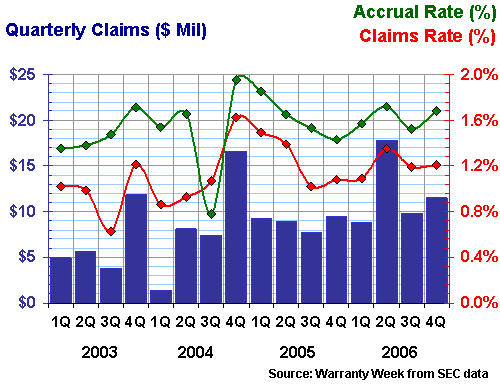
Harman International exhibits a somewhat unpredictable pattern of claims and accruals. Claims per quarter have ranged from a low of $1.4 million in the first quarter of 2004 to a high of $17.8 million in the second quarter of 2006. As a percentage of sales, the company's claims rate has swung from 0.6% to 1.6%. Accruals have exceeded claims for 15 of the past 16 quarters, and have ranged as high as 1.9% and as low as 0.8% of sales.
None of these CE manufacturers exhibited anything approaching a cyclical or seasonal pattern for their claims or accruals. Intuitively, one would think that the fourth quarter would see a surge in sales and the first quarter would see a surge in post-holiday claims. But it's just not there to be found.
Navigational Devices
Garmin Ltd. manufactures navigational equipment for both the aerospace and consumer markets. Its bestselling product line consists of Global Positioning System receivers that initially helped guide military personnel in the field but which lately have been adapted by millions of car-bound consumers who refuse to pull over and ask for directions.
Figure 3
Garmin Ltd.
Warranty Claims & Accruals, 2003 to 2006
(in $m and % of Product Sales)
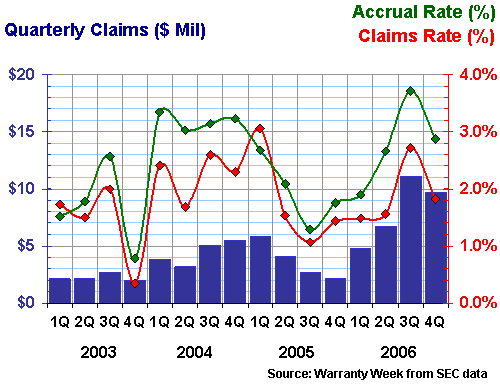
Garmin is very proud of its after-sale commitment to service, and it shows in its warranty expenditures. While the Japanese CE manufacturers have managed to keep their claims rates well below 1%, Garmin has attained that level only once in the past 16 quarters. High levels of customer service create additional costs.
As sales continue to grow, so do warranty claims. In 2006, sales were up 73% but warranty claims were up 119%. And it shows in the claims rate depicted in Figure 3. At first glance, Garmin looks more like a computer company than a CE company -- as if those little GPS receivers really were handheld computers.
Indeed, there does seem to be a sharp dividing line between traditional CE and computer-like CE. When your CD player or pocket radio breaks, you throw it away and get a new one. But when your iPod or GPS receiver breaks, you seek out a repair. We suspect that's why Sony is at the top of the four companies in Figure 1: it has a significant computer business to contend with, and computers attract warranty claims at rates even higher than automobiles.
Digital Projectors
Speaking of computers, InFocus Corp. is one of those companies that could fit within either the computer peripheral business or the CE industry. InFocus makes a wide array of projectors for both the office and school markets as well as home entertainment applications. What made us put them into the consumer category was their claim of having sold more than a million projectors, and being the first to ship a digital HDTV projector for the home. That sounds like a home entertainment company, not an office equipment manufacturer.
Figure 4
InFocus Corp.
Warranty Claims & Accruals, 2003 to 2006
(in $m and % of Product Sales)
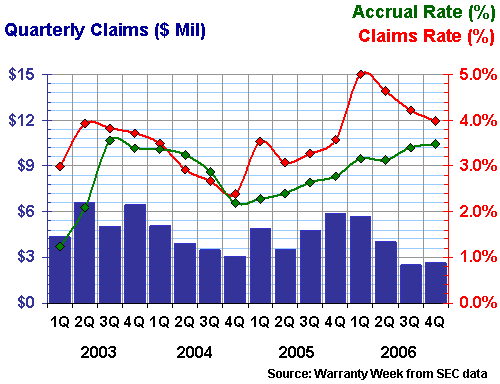
InFocus has a more predictable warranty spending pattern, but it's also now headed for the high side in terms of warranty claims rates. Though the peak rate occurred in early 2006 during a product recall, a 4% year-end claims rate is nothing to boast about either. Then again, the company's claims rate has fallen below 3% in only three of the last 16 quarters.
Radio Check
Cobra Electronics makes radar detectors, Citizen's Band radios, marine radios, and lately, a new family of GPS receivers. Over the past four years, its warranty position has continuously improved, falling from the 5% range in early 2003 to less than half that rate of spending now.
Figure 5
Cobra Electronics Corp.
Warranty Claims & Accruals, 2003 to 2006
(in $m and % of Product Sales)
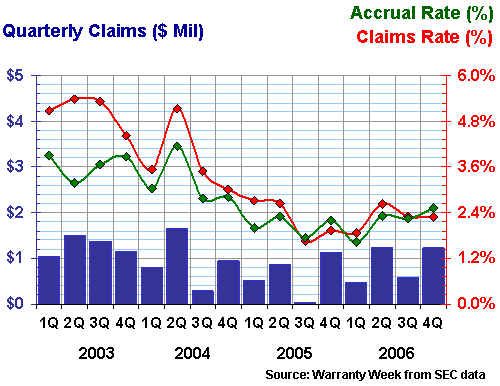
Cobra Electronics also began 2003 with a wide divergence between its claims and accrual rates, and unlike Harman or Garmin, it was with accruals significantly below claims. As a result, its warranty reserves dropped below the $1 million level once in 2003 and once in 2004. However, claims and accruals are closer now, and the reserve balance is now approaching $2 million, although that's a pretty thin cushion with claims now arriving at a rate of $410,000 per month.
Turn Up The Volume
Loud Technologies has one of those perfect corporate names that clearly describes the product line. Best known for professional audio brands such as Alvarez, Ampeg, and Crate, the company manufactures produces a wide range of digital recording products, loudspeakers, guitars, amplifiers, commercial audio systems, and orchestral string instruments. What would be even more perfect is if the latter product line could somehow be reorganized into the Quiet Division.
Figure 6
Loud Technologies Inc.
Warranty Claims & Accruals, 2003 to 2006
(in $m and % of Product Sales)
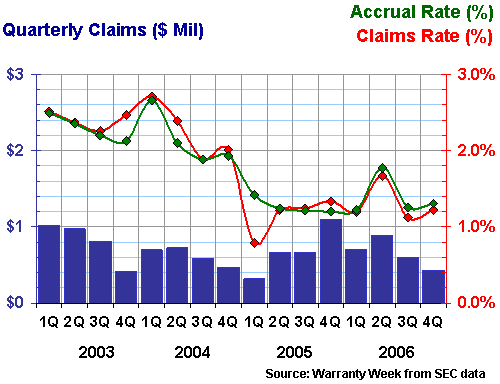
Its warranty expenditures are not loud at all, however. Claims and accruals peaked at 2.7% in early 2004, and have been on a downward slope ever since. In fact, while sales were up 5% last year, claims paid were down 4%. But claims as a percent of sales remains stubbornly close to the 1.2% level.
Beautiful Music
Henry Engelhard Steinway began making pianos more than 150 years ago in New York City. Steinway & Sons still has a piano factory across the river in the boro of Queens, and today that company is owned by a holding company called Steinway Musical Instruments Inc. But the parent company has also acquired a wide array of musical instrument companies and brand names that could fill virtually every seat in the orchestra pit.Figure 7
Steinway Musical Instruments Inc.
Warranty Claims & Accruals, 2003 to 2006
(in $m and % of Product Sales)
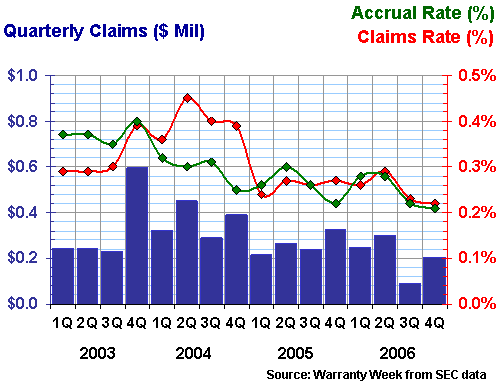
Its warranty experience has been almost Japanese-like over the past four years, leading us to wonder if perhaps there's a fundamental difference between acoustic and electric instruments. Perhaps there is a heretofore unknown relationship between volume and warranty claims? In fact, let us go a step further and blame the recent rise in automotive warranty claims on the higher wattage of today's car audio systems, and how they shake and rattle the chassis when a good song comes on the radio.
Keep in mind, however, that this is a very small slice of the entire consumer electronics industry. The 17 U.S.-based companies we're placing into the CE-only category have total annual CE sales of about $11 billion, and that's out of a total U.S. market of $155 billion. So the real story of CE warranties lies with the importers who report little if anything about their warranty expenditures.
| Back to Part Four | Go to Part Six |








